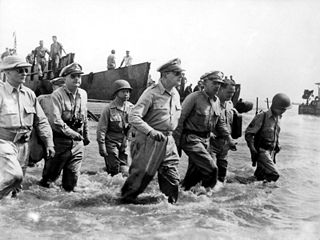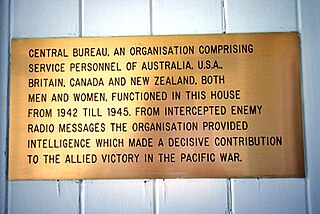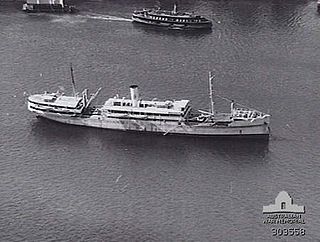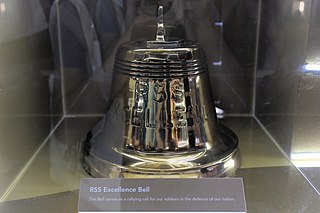Related Research Articles

The United States 32nd Infantry Division was formed from Army National Guard units from Wisconsin and Michigan and fought primarily during World War I and World War II. With roots as the Iron Brigade in the American Civil War, the division's ancestral units came to be referred to as the Iron Jaw Division. During tough combat in France in World War I, it soon acquired from the French the nickname Les Terribles, referring to its fortitude in advancing over terrain others could not. It was the first allied division to pierce the German Hindenburg Line of defense, and the 32nd then adopted its shoulder patch; a line shot through with a red arrow, to signify its tenacity in piercing the enemy line. It then became known as the Red Arrow Division.

South West Pacific Area (SWPA) was the name given to the Allied supreme military command in the South West Pacific Theatre of World War II. It was one of four major Allied commands in the Pacific War. SWPA included the Philippines, Borneo, the Dutch East Indies, East Timor, Australia, the Territories of Papua and New Guinea, and the western part of the Solomon Islands. It primarily consisted of United States and Australian forces, although Dutch, Filipino, British and other Allied forces also served in the SWPA.

The Philippines campaign, also known as the Battle of the Philippines or the Fall of the Philippines, was the invasion of the Philippines by the Empire of Japan and the defense of the islands by United States and the Philippine Armies during World War II.

The New Guinea campaign of the Pacific War lasted from January 1942 until the end of the war in August 1945. During the initial phase in early 1942, the Empire of Japan invaded the Territory of New Guinea on 23 January and Territory of Papua on 21 July and overran western New Guinea beginning on 29 March. During the second phase, lasting from late 1942 until the Japanese surrender, the Allies—consisting primarily of Australian forces—cleared the Japanese first from Papua, then New Guinea, and finally from the Dutch colony.

Arthur Schuyler Carpender was an American admiral who commanded the Allied Naval Forces in the Southwest Pacific Area during World War II.

The Philippines campaign, Battle of the Philippines, Second Philippines campaign, or the Liberation of the Philippines, codenamed Operation Musketeer I, II, and III, was the American, Mexican, Australian and Filipino campaign to defeat and expel the Imperial Japanese forces occupying the Philippines during World War II.

Australia entered World War II on 3 September 1939, following the government's acceptance of the United Kingdom's declaration of war on Nazi Germany. Australia later entered into a state of war with other members of the Axis powers, including the Kingdom of Italy on 11 June 1940, and the Empire of Japan on 9 December 1941. By the end of the war, almost a million Australians had served in the armed forces, whose military units fought primarily in the European theatre, North African campaign, and the South West Pacific theatre. In addition, Australia came under direct attack for the first time in its post-colonial history. Its casualties from enemy action during the war were 27,073 killed and 23,477 wounded. Many more suffered from tropical disease, hunger, and harsh conditions in captivity; of the 21,467 Australian prisoners taken by the Japanese, only 14,000 survived.

The Central Bureau was one of two Allied signals intelligence (SIGINT) organisations in the South West Pacific area (SWPA) during World War II. Central Bureau was attached to the headquarters of the Supreme Commander, Southwest Pacific Area, General Douglas MacArthur. The role of the Bureau was to research and decrypt intercepted Imperial Japanese Army traffic and work in close co-operation with other SIGINT centers in the United States, United Kingdom and India. Air activities included both army and navy air forces, as there was no independent Japanese air force.

The South West Pacific theatre, during World War II, was a major theatre of the war between the Allies and the Axis. It included the Philippines, the Dutch East Indies, Borneo, Australia and its mandate Territory of New Guinea and the western part of the Solomon Islands. This area was defined by the Allied powers' South West Pacific Area (SWPA) command.

USS Triangulum (AK-102) was a Crater-class cargo ship commissioned by the US Navy for service in World War II. Triangulum was named after the constellation Triangulum. She was responsible for delivering troops, goods and equipment to locations in the Asiatic-Pacific Theater.
The Pensacola Convoy is a colloquialism for a United States military shipping convoy that took place in late 1941 as the Pacific War began. The name was derived from that of its primary escort ship, the heavy cruiser USS Pensacola. Pensacola was officially designated Task Group 15.5 and Army sources may use the term Republic convoy for the senior convoy vessel. The convoy, dispatched in peacetime, was intended to reinforce the United States Army Forces Far East (USAFFE), created to defend the U.S. Commonwealth of the Philippines and commanded by General Douglas MacArthur, with artillery, aircraft, munitions and fuel, as the threat of war with the Empire of Japan loomed. After war broke out, and Japanese forces attacked the Philippines, the convoy was diverted to Brisbane, Australia.

Allied submarines were used extensively during the Pacific War and were a key contributor to the defeat of the Empire of Japan.

Operation Lilliput was the name given to a convoy operation directed by G.H.Q. Operations Instructions Number 21 of 20 October 1942 for transportation of troops, weapons, and supplies in a regular transport service between Milne Bay and Oro Bay, New Guinea between 18 December 1942 and June 1943 in order "to cover reinforcement, supply, and development of the Buna-Gona area upon its anticipated capture" by the Australian 7th Division and the United States Army's 32d Division. Within six months, the convoys, escorted by Royal Australian Navy corvettes and largely composed of Dutch KPM merchant ships, had delivered 60,000 tons of supplies and 3,802 troops from Milne Bay to Oro Bay. Corvettes provided the majority of the escort force. Losses during Imperial Japanese air attacks amounted to two merchant ships, 's Jacob and Van Heemskerk, sunk and two badly damaged while several of the corvettes also sustained damage and casualties.

The invasion of Buna–Gona, called Operation RI by the Japanese, was a military operation by Imperial Japanese forces to occupy the Buna–Gona area in the Territory of Papua during the Pacific campaign of the Second World War. The initial landings and advance on Kokoda occurred between 21 and 27 July 1942. The Japanese invaded and occupied the location in preparation for an overland attack on Port Moresby along the Kokoda Track. The landing marked the start of the Kokoda Track campaign. The landings were not directly opposed by land forces but were engaged by elements of Maroubra Force as they advanced on Kokoda. This initially included B Company of the 39th Battalion, patrols of the Papuan Infantry Battalion (PIB) operating in the area and a small number of the Australian New Guinea Administrative Unit (ANGAU) that became attached to the force. The Australians were initially repulsed near Oivi but subsequently regrouped to defend Kokoda in an initial battle there from 28–29 July.
At the beginning of World War II, the Royal Navy was the strongest navy in the world, with the largest number of warships built and with naval bases across the globe. It had over 15 battleships and battlecruisers, 7 aircraft carriers, 66 cruisers, 164 destroyers and 66 submarines. With a massive merchant navy, about a third of the world total, it also dominated shipping. The Royal Navy fought in every theatre from the Atlantic, Mediterranean, freezing Northern routes to Russia and the Pacific ocean.

Don Esteban, delivered in 1936, was the first and smaller of two Krupp built motor ships of the De La Rama Steamship Company, Iloilo, Philippines in inter-island service. The ship was under a bareboat charter by the United States Army as a transport on 30 October 1941 for use in pre positioning U.S. Army Air Corps (USAAC) fuel and munitions in the southern Philippines, Netherlands East Indies, Singapore and Australia. After the Japanese invasion of the Philippines she evacuated personnel from the Army headquarters, including General MacArthur, from Manila to Corregidor on Christmas Eve, 1941. The ship was lost off Mindoro on 2 March 1942 while continuing its supply missions.

SS Mactan was launched 28 December 1898 as the passenger/cargo ship North Lyell for North Mount Lyell Copper Co.Ltd. intended for service between the west coast of Tasmania and Melbourne. The company no longer needed the ship on delivery in 1899 with resulting sale to Union Steamship Company of New Zealand Ltd. and renaming as Moura. In 1915 upon sale to the Douglas Steamship Company, Ltd. of Hong Kong she was renamed Hai Hong. Upon sale to Philippine operators in 1928 the ship gained the final name Mactan.

The Battle of Buna–Gona was part of the New Guinea campaign in the Pacific Theatre during World War II. It followed the conclusion of the Kokoda Track campaign and lasted from 16 November 1942 until 22 January 1943. The battle was conducted by Australian and United States forces against the Japanese beachheads at Buna, Sanananda and Gona. The Allied advance on the Japanese positions at Buna–Gona was made by the 16th and 25th Brigades of the Australian 7th Division and the 126th and 128th Infantry Regiments of the US 32nd Infantry Division. During the course of the battle, a further four infantry brigades, two infantry regiments and an armoured squadron of 19 M3 Stuart tanks were deployed.

USS LST-629 originally was a United States Navy LST-542-class tank landing ship built during World War II and in commission from 1944 to 1946 and again in the late 1952. She was sold to the Republic of Singapore Navy and renamed RSS Excellence (L-202).
USS LST-579 originally was a United States Navy LST-542-class tank landing ship built during World War II and in commission from 1944 to 1946 and again in the late 1952. She was sold to the Republic of Singapore Navy and renamed RSS Intrepid (L-203).
References
- 1 2 "Welcome". US Army Small Ships Association Inc.
- 1 2 3 4 5 6 Small Ships Section, Southwest Pacific Area of World War II, by Richard E. Killblane (United States Army Transportation Corps), pg. 1.
- 1 2 Babcock, Kenneth (2014). "MacArthur's small ships: Improvising Water Transport in the Southwest Pacific Area". Army History. No. 90 (90): 26–42. JSTOR 26298870 – via JSTOR.
- 1 2 Erin, Frick (21 March 2014). "On This Day: The Ragtag Fleet is Born". Australian Geographic. Retrieved 12 May 2021.
- ↑ "Australian Department of Defence".
- ↑ webadmin (2012-04-11). "United States Army Small Ships Section Memorial". www.warmemorialsregister.nsw.gov.au. Retrieved 2021-05-12.